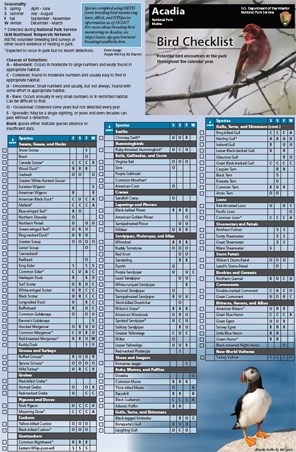
Sarah O'Malley/MMA
Overview
Founded in 1916, Acadia National Park has a rich human history that includes Native Americans, European settlers, artists, conservationists, and more.The park protects 40 miles of rocky shoreline and contains over 47,000 acres of rugged, primarily island topography carved and shaped by a succession of continental glaciers. With its bare, rounded mountain summits, verdant forests, sea cliffs, boulder beaches, deeply indented coastline, carriage trails, pristine ponds and lakes, headlands jutting into the sea, and remote islands, the park captures the extraordinary beauty and charm of the Maine coast.
Acadia is positioned within the broad transition zone between eastern deciduous and northern coniferous forests, and hosts several species and plant communities at the edge of their geographic range. Steep slopes rise above the rocky shore, including Cadillac Mountain, which at 1,530 feet is the highest point on the U.S. Atlantic coast. While surrounded by the ocean, the entire fabric of Acadia is interwoven with a wide variety of freshwater, estuarine, forest, geologic, and intertidal resources, many of which contain plant and animal species of international, national and state significance.
Lakes and ponds cover about 2,600 acres of the park. Of these, 14 are 'Great Ponds' (natural bodies of water greater than 10 acres). In addition, over 20% of Acadia National Park includes wetlands of all types (marine aquatic beds, intertidal shellfish flats, salt marshes, freshwater marshes, forested wetlands, and peatlands).
Long Term Monitoring Programs in the Park
Source: NPS DataStore Saved Search 1187 (results presented are a subset). To search for additional information, visit the NPS DataStore.
Source: NPS DataStore Saved Search 2272 (results presented are a subset). To search for additional information, visit the NPS DataStore.
Source: NPS DataStore Saved Search 1189 (results presented are a subset). To search for additional information, visit the NPS DataStore.
Source: NPS DataStore Saved Search 2483 (results presented are a subset). To search for additional information, visit the NPS DataStore.
Source: NPS DataStore Saved Search 1458 (results presented are a subset). To search for additional information, visit the NPS DataStore.
Source: NPS DataStore Saved Search 2285 (results presented are a subset). To search for additional information, visit the NPS DataStore.
Source: NPS DataStore Saved Search 1122 (results presented are a subset). To search for additional information, visit the NPS DataStore.
Park Basline Inventories
The Inventory and Monitoring Program provides guidance, funding, and technical assistance for parks to complete a set of 12 baseline, or "basic", natural resource inventories. These basic inventories are common to all parks with significant natural resources, and are intended to provide park managers with the minimum information needed to effectively manage the natural resources of their park.
| Baseline Inventories | Complete for Park? | Reports, Documents & Data |
|---|---|---|
| Water Quality | Y | Baseline Inventory |
| Y | Cartographic data sets: U.S. Geological Survey and U.S. Department of Agriculture. National Park Service data clearinghouse for mapping information and geospatial resources. | |
| Mammal Inventory | Y | An Inventory of Terrestrial Mammals at National Parks in the Northeast Temperate Network and Sagamore Hill National Historic Site |
| Air Quality Related Values | Y | Park Air Profiles - Acadia National Park |
| Climate Inventory | Y | Weather and Climate Inventory for NETN parks |
| Geological Resources Inventory | Y | |
| Soil Resources Inventory | Y | NPS - SRI - Soil Survey Geographic (SSURGO) |
| Water Body Location and Classification | Y | |
| Vegetation Inventory | Y | Vegetation Inventory and Map |
| Species Lists | Y | IRMA Species Search |
| Species Occurrence and Distribution | Y | Biological Resources Search on IRMA |
Park Species Lists
Species lists are available from NPSpecies, the National Park Service's tool for documenting park biodiversity. Keep in mind that these species lists are a work-in-progress. Changes and updates are made as more species are shepherded through a rigorous vetting process. The absence of a species from a list produced with the tool below doesn't necessarily mean the species is absent from a park.Select a Park:
Select a Species Category (optional):
Visit NPSpecies for more comprehensive information and advanced search capability. Have a suggestion or comment on this list? Let us know.
Natural Resource Briefs for Acadia National Park
Click link below to view all the short briefs about the long-term monitoring and natural resouces of the park.Source: NPS DataStore Saved Search 3746. To search for additional information, visit the NPS DataStore.

Non NPS Citizen Science Opportunities in the Park
Bird observations from eBird
Acadia National Park has been set up in eBird as a birding "hotspot". Help the park bolster bird data by adding your bird obsevations to eBird when you visit the park.Download and print off a Bird Checklist for the park. The bird list was created using data from the volunteer run NETN Breeding Landbird Monitoring program, eBird observations, and NPSpecies information
Species observations from iNaturalist
Acadia Science Stories
Last updated: November 14, 2025
